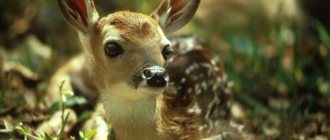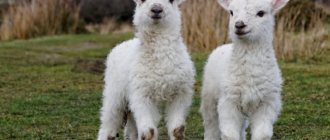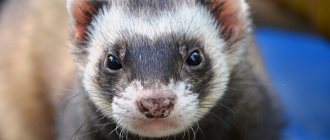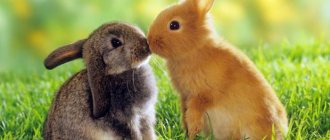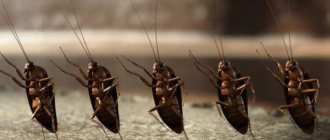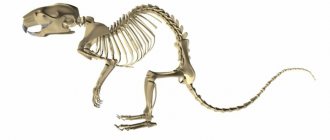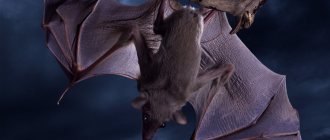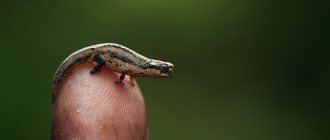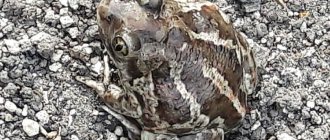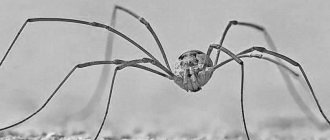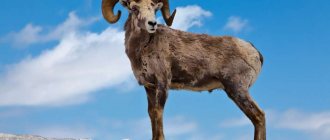Mountain goats are artiodactyl animals that naturally live in mountainous areas. O Agile and hardy animals, capable of climbing a steep cliff and living on sparse vegetation. Domesticated mountain goats are simply called domestic goats.
In different mountain regions of the world, there are several species of mountain goats, which have their own “secondary” names - ibex, aurochs, tek, jim, bun, etc. But these are all representatives of the same species - the mountain goat.
Description of the Alpine ibex
The body length of the Alpine mountain goat is about 1.5 m, height up to 0.9 cm. The weight of males reaches 100 kg, the weight of females is approximately 40 kg. Adult males have impressive curved horns, up to 1 m in length; females have short horns, slightly curved. The head is longitudinal, and both males and females have a characteristic “beard” on the lower jaw. The fur of the animals is brown, lighter in females, and the belly is yellowish. The tail is flat, without fur below. The legs are short and powerful, with hooves.
Capricorn Ibex
Belongs to rare species of animals. Lives in Savoy and Piedmont. An adult ibex can reach a live weight of 90-100 kilograms, females weigh up to 40 kilograms. Ibex has arched horns. Which are quite heavy, their weight can be up to 15 kg and 1 meter long. The male has dark brown fur, while the females have red fur with a golden tint. In winter, both the female and the male change their coat color to gray.
Nutritional characteristics of the Alpine mountain goat
— Advertising —
In the early morning, the alpine mountain goat goes to graze in mountain meadows and grassy areas, where it spends the whole day, eating branches of bushes and trees. Reaching the branches, the animal stands on its hind legs. Preference is given to grass and low-growing plants. The goat spends the hot afternoon high on the rocks.
The plant foods that animals eat do not always contain a sufficient amount of mineral salts, so they are often sent to salt licks. In these places, Alpine ibex are often attacked by predators (brown bear, wolf, lynx, fox). To escape from them, the animal often runs onto narrow rock ledges or tops of rocks, where predators cannot reach.
Species features
Animals included in the genus of mountain goats in terms of species diversity have external differences, behavioral characteristics and habitats. The most numerous species is the domestic goat; at the beginning of the 21st century, the total number in the world exceeded 700 million individuals, which is many times greater than the total population of other mountain goats.
Capricorns
The largest group of mountain goats, including 4 species and many subspecies, differing in external characteristics and regions of distribution. These groups of animals were combined into one subgenus, Capricorns, due to the similar structure of their horns. They have a saber shape, a triangle in cross section, and the surface of the horn is covered with transverse thickenings. The Siberian mountain goat has 4 subspecies.
| Index | Siberian mountain goat | Alpine ibex | Iberian ibex | Nubian ibex |
| Habitats | from the northern regions of India and Afghanistan to Mongolia and southern Siberia. | Alps, on the border of the forest zone and the ice cap. | Spain and Portugal | Arabian Peninsula, North Africa, Ethiopia |
| Height at withers, cm | 67-110 | 65-100 | 65-75 | 60-80 |
| Body length, cm | 130-165 | Up to 150 | 100-140 | Up to 125 |
| Live weight, kg | 35-130 | Females up to 50, males up to 100 | 35-80 | 25-70 |
| Horn length, cm | up to 110 | Up to 100 | Up to 80 | Up to 100 |
| Main color | brown | Dark brown in goats. Females have a golden tint. | From light to red-brown. | Dark brown with black stripe. |
Animals are distributed over a wide area - from the Atlantic Ocean to the Himalayan mountains. Capricorns, thanks to their majestic appearance, have received great recognition in human culture. The image of this goat was often present on coins and state symbols. At night you can spot the constellation Capricorn.
Tours
These animals are not so graceful and in appearance are very similar to domestic goats, from which they are distinguished only by the presence of thick curled horns. Turs have a strong, heavy build - with a height at the withers of up to 110 cm, their weight can exceed 110 kg. The aurochs' horns are strongly rounded - they almost make a full rotation, which makes them stand out from other goats.
There are two types: Western Caucasian and Eastern Caucasian turs, which are often called Caucasian mountain goats. Despite their similar structure, close relationship and neighboring habitats, these animals cannot produce full-fledged offspring; all resulting hybrids are sterile. This problem has become especially acute in recent years, when habitats have become highly intermixed and the number of hybrids has increased sharply. This is due to the growing influence of humans in the region.
Goats
They are the largest and most diverse subgroup. This is due to the activities of humans who tamed the domestic goat several thousand years ago. Currently, there are over 100 breeds of domestic goats, which are grouped according to the type of productivity: dairy, wool, down, meat. Depending on the breed, goats will vary greatly:
- the smallest dwarf breeds weigh up to 10 kg, and large meat goats weigh over 150 kg;
- height at the withers in dwarf individuals does not exceed 40-50 cm, and in Nubian goats it can exceed 130 cm;
- most dairy breeds have short hair, and animals of the downy and wool type are covered with thick fur up to 15 cm long or more;
- Coloration also varies greatly between animals - from solid white and brown, to spotted ones.
Domestic goats live not only on farms and garden plots. These animals easily run wild - populations of feral goats are found on the Mediterranean islands. There is also a separate subspecies of bezoar goats, which in the distant past was used in breeding domestic animals. It is native to Western Asia and can easily interbreed with domestic goats.
The mark-horned goat is found in the Himalayas, mountains of Afghanistan, Tajikistan and Uzbekistan. It is also included in this subgroup, but it is distinguished by the unusual shape of its horns - they are straight, but twisted like a corkscrew in different directions. The length of the horns can reach a meter, while the length of the animal itself does not exceed 150 cm. Females are much smaller, but their horns are not large - up to 20 cm. Now there are still 8 species of goats and several dozen subspecies, but the increasing influence of humans can lead to complete the disappearance of most of these animals in the near future.
Male and female alpine ibex: main differences
Alpine ibex females are much smaller in size than males, 1.5-2 times in weight. In addition, sexual dimorphism for them is manifested in the fact that they have small curved horns, in contrast to the powerful, up to 1 m in length, horns of males.
Caucasian mountain tours
They are divided into three subspecies. The West Caucasian Tur lives in the mountainous areas of the Caucasus and has short, orange fur. The horns are large and large, located to the sides and have a slight bend. There are transverse hollows on the surface of the Horns. The Caucasian Mountain Goat also has a large body weight, can reach up to 100 kg, height at the withers is 110 cm. Females are much smaller in size. This type of aurochs is endangered; there are just under 10,000 animals left.
Alpine ibex behavior
— Advertising —
Alpine mountain goats live in small groups, males and females are separated; only sick and old individuals occasionally lead a solitary lifestyle. Females create herds together with young immature kids. Only during mating games do males and females meet and are close together. At this time, the dominant male forms a harem of several females.
Animals are active during daylight hours and at night they go to rest in safe high mountain areas. In the mornings they search for food, leisurely walking along mountain slopes or alpine meadows at high altitudes. They usually live at an altitude of 2000-3000 m above sea level. In case of any danger, Capricorns are able to instantly hide in rocky crevices.
They spend the spring high in the mountains, and in the winter they often descend into the valleys. Where they live, there are characteristic paths that go to watering holes and down the mountain slopes. During heavy snowstorms, alpine mountain goats always gather in close groups. In the hot season, on the contrary, they remain close to glaciers and snow. This animal is very careful, thanks to its well-developed vision, hearing and sense of smell, it is able to smell and see an approaching person over long distances.
Secret hooves and fast jumps
Part of the hoof, on the contrary, never hardens, and its cells are constantly renewed. Due to this, this part of the animal’s “sole” remains soft and pliable throughout its life. Stepping on the sharpest stone with its hoof, the goat does not fall, since its soft tissues on the soles follow the shape of the surface of the protrusions and peaks. It’s as if they are imprinted or glued to the dangerous mountain outlines. If an animal feels that it might lose its balance at the moment, it immediately jumps to another place with enviable speed and ease.
Jumping does not stop until the individual takes a firm position on the rock cover. Of course, such daily “training” gives the leg muscles of artiodactyls power and strength. After all, kids start running and jumping on rocks in infancy. The speed and maneuverability of movements allows the inhabitants of mountain peaks to move long distances to search for food and quickly escape from birds of prey, wolves or snow leopards.
Alpine ibex breeding
The mating season for the Alpine mountain goat lasts from December to January, and all this time the males fight with each other.
During the fight, opponents rear up, direct their entire weight forward, and fight with their horns. Serious injuries are extremely rare, but they are capable of pushing each other into abysses and crevices. The duration of pregnancy reaches 6 months, one kid is born, the weight of the newborn is about 3 kg. During the first year of life, milk feeding continues, but at the same time the baby learns to eat plants. When the kid becomes able to move deftly along the rocks, the female leaves him and returns to her herd.
Females become sexually mature at 2-3 years, males at the age of 3-4 years. After this, young males leave their herd and go to bachelor groups. From the age of six, when large antlers are formed, they begin to participate in fights for females.
History of appearance
The beginning of hunting these animals dates back to ancient times. The place where people first took these animals into their homes is considered to be the north of Iran. The horns of a large male were coveted trophies among tribal peoples in different parts of the world. Finding and trapping such an animal was not an easy task.
From these animals, people learned to peel off the skins from which they made shoes and clothes, and used them as material for homes. Mountain goat meat was especially prized and was considered a delicacy by ancient people. People also used fat in food. After extracting so many useful products from goats, ancient man domesticated wild goats along with dogs. That is why there are now so many different breeds of this magnificent animal in the world, for example, meat, dairy, intended for fluff, and others.
In the Middle Ages, their skins were used to make containers for food and wine. Wild goat milk is still valued for its nutritional properties.
In the modern world, mountain goats can be found high in mountain cliffs, or in large zoos. There they easily take root and reproduce brilliantly.
Since ancient times, it was believed that goats are symbols of dark, evil or devilish power. However, they are actually very intelligent creatures and are highly trainable. One of the constellations is named after Capricorn, named after these representatives of the animal kingdom. Their outlines can be found in the drawings of many peoples inhabiting Eurasia.
Natural enemies of the alpine ibex
Today, about 30,000 – 40,000 Alpine ibex live in the Alps. But the species could have disappeared at the beginning of the 19th century due to the fact that it was considered mystical in the Middle Ages. Bones, hair, blood and even excrement were endowed with magical and mysterious healing properties. For this reason, hunting for animals was especially active. By the beginning of the 19th century, about 100 individuals remained in the wild, in Gran Paradiso in Italy. Local scientists convinced the authorities to take measures to protect and preserve the species. In the mid-19th century, King Emmanuel II himself began protecting the Alpine mountain goat, and they were even banned from being exported outside the country. Half a century later, several animals were smuggled into Switzerland. Today's population of alpine ibex is descended from those animals that were rescued by scientists in the 19th century. And now the population is considered stable, is no longer endangered, and animals are even subject to controlled shooting.
What do they eat?
Mountain goats feed on everything they find in the mountains: grasses, branches of bushes, mosses, lichens. They taste everything they see and then decide whether they will eat it or not. Wild animals eat bark, leaves, fruits. If desired, they can climb a tree. They love salt very much, for which they even climb the walls of a concrete dam. Animals graze early in the morning or late in the evening. At lunchtime they rest or hide in the shade from the sultry sun. In places where predators can lie in wait for them, they go out to pasture only at night, and during the day they hide in rocks.
Interesting facts about the Alpine ibex
- The horns of a male Alpine mountain goat reach about 1 m in length.
- This species, like other goats, is characterized by a special, pronounced “goat smell”. Animals may spray themselves with urine.
- In Medieval times, people used all parts of the body, as well as the blood, fur and feces of ibex, as medicinal products. Because of this, the animals were actively hunted and the population was almost completely exterminated until the beginning of the 19th century, after which the species was taken under protection and restored.
Dangers and Enemies
Mountain goats live their entire lives in hard-to-reach mountain areas, escaping from predators. They are hunted by bears and wolves, lynxes and leopards, panthers, tigers, and leopards. Small goats can become prey for golden eagles, eagles, kites, and hawks. Danger lurks everywhere for these wild mountain animals. In winter, they die due to avalanches, severe frost and cold winds. In summer, humans hunt animals. True, many rare species (alpine, markings, Severtsova) are protected by law, that is, hunting them is prohibited.
Mystery of nature
Many people wonder how such large mammals manage to stay on steep rocks? It's all about strong, small hooves. The hard hoof horn allows you to stand in a very small area without experiencing discomfort.
A tiny ledge on the rock will be enough for the animals not only to maintain their balance, but also to be able to run along steep slopes. The hooves are equipped with ultra-sensitive pads that provide additional traction on rocky surfaces. In addition to their hooves, goats are helped to stay on steep rocks by:
- exceptional sense of balance;
- filigree coordination of movements;
- acute vision, allowing you to notice even small stone protrusions.
If, having stood on a stone, the animal realizes that it is too small and it will not be possible to stay on it, it instantly finds the next ledge, to which it quickly jumps.
The importance of protecting the Dagestan tour
The number of turs was once quite large. The reasons why this animal species is on the verge of extinction today are as follows:
- Illegal hunting (poaching).
- Predator attack.
- Natural disasters (for example, avalanches in the mountains).
Since Caucasian mountain goats have long been the object of hunting, their numbers gradually decreased. In the old days (and even today), aurochs horns were considered a reputable hunting trophy, as a result of which these animals are becoming less and less numerous. In addition, predators, mostly lynxes and wolves, also caused great damage to the livestock.
According to various sources, only 10 to 16 thousand individuals have survived in nature. Today, the tour is listed in the Red Book by the International Union for Conservation of Nature. But, there are some nuances that need to be clarified. The fact is that this organization has included both types of aurochs on the list of protected animals. But the Western Caucasian one is included in the Red Book in the “endangered” category, but the East Caucasian one belongs to the “close to endangered” category.
The crossing of these two species also poses a danger of extinction. Animals do not really understand that they belong to different species, therefore, as a result of such “meetings”, hybrid individuals are born that cannot give birth to offspring, which is another reason for the gradual decline in the population.
Despite the fact that the mountain goat is listed as a specially protected animal, it is still in danger from humans. For example, hunting for the Dagestan tur is still allowed in Azerbaijan. If a hunter has a shooting license, he can hunt these animals from July to August.
In order to prevent this animal from disappearing from our planet altogether, people are engaged in their reproduction. In Azerbaijan there is a separate farm for breeding turs.
Elite vessels for wine are made from aurochs horns. It is considered a valuable gift in the Caucasus and far beyond its borders. A wine vessel made of horn is considered a symbol of the antiquity of the Caucasian people, demonstrating their attachment to ancient foundations and traditions.
A wine horn is a very popular gift for a real man. A large selection of elite tour horns is presented in the KavkazSuvenir online store. Works by the best Caucasian masters are available for order from all over Russia and the world.
Tradition says that by drinking from a horn filled to the brim with wine, a person will ensure abundance and prosperity in his home. The customs of hospitality require the use of such a vessel for wine when welcoming a guest, becoming a gift for him (after draining). Such horns are usually framed with precious metals and decorated using minting or engraving technologies.
